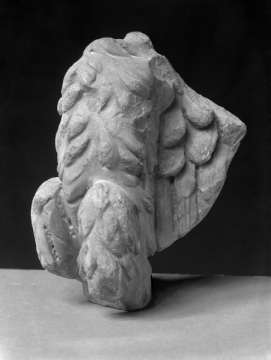Explore Collections


You are here:
CollectionsOnline
/
Fragment of an eagle from a Roman altar or piece of furniture
Browse
Eagle SM S41. ©A.C. Cooper (colour) Ltd
Fragment of an eagle from a Roman altar or piece of furniture
69-96 AD
Probably Flavian
Probably Flavian
Greek island marble
Height: 21cm
Width: 15cm
Thickness: 9cm
Width: 15cm
Thickness: 9cm
Museum number: S41
On display: Study
All spaces are in No. 13 Lincoln's Inn Fields unless identified as in No. 12, Soane's first house.
For tours https://www.soane.org/your-visit
Curatorial note
Fragment of the body and left wing of an eagle, part of the base of a Roman altar or a decorative element from a piece of Roman furniture. The unfinished surface behind the wings and at the upper back of the tail indicate that this piece was primarily intended to be viewed from the front and from its left side. The fact that the right side is also sculpted means it cannot have been broken from a high relief sculpture and its size and unrefined style make it unlikely to have been the eagle-attribute of a divine (Jupiter) or Imperial statue.
This piece is probably the reworked fragment of the base of a funerary altar or perhaps even the remains of marble furniture enrichment. The thickness of tail and bottom of the wings suggest that a main source of joining or support was carried through here, but the surface has probably been reworked by a restorer ready for use. This would account for the disparity in style between the antique left and the recreated right and rear surfaces of the wings and body. A not unlikely parallel source for this fragment is exemplified by the eagle which supports the bust of Sol in high relief on the Flavian altar dedicated to Sol Sanctissimus in the Museo Capitolino, Rome1.
The motive of the eagle of Apotheosis progressed from the large cameos of the early imperial period to the figure of Titus on an eagle above the passage-way of the Arch of Titus in Rome, and to all the Hadrianic, Antonine and later representations of imperial persons being carried heavenwards on the backs of eagles. The imperial coins spread the design into the popular or private arts2.
1 H.S. Jones (Ed.), A Catalogue of Ancient Sculptures Preserved in the Municipal Collections of Rome: Museo Capitolino, Oxford, 1912, p. 47; E. Strong, La Sculptura Romana da Augusto a Constantino, trans. Giulio Giannelli, Florence, 1923, II, p. 314f., fig. 191.
2 See L. Vogel, The Column of Antoninus Pius, Cambridge (Massachusetts), 1973, pls./figs. 3 (the sculptured base of the column with the eagles attending the Apotheoisis), 87 (cameo in Paris with a similar type of scene), 94, 95 (coins of Antoninus Pius); G. Lippold, Die Skulpturen des Vaticanischen Museums, III, pt. 2, pl. 34 (Sala della Biga), no. 610a (altar of Q. Pomponius Eudaemon and Pomponia Helpis, each going up to heaven on opposite sides on a bird); Lippold, Text Volume, pp. 68-69: from the Mattei collection and drawn in the Dal Pozzo - Albani collection: see p. 535.
This piece is probably the reworked fragment of the base of a funerary altar or perhaps even the remains of marble furniture enrichment. The thickness of tail and bottom of the wings suggest that a main source of joining or support was carried through here, but the surface has probably been reworked by a restorer ready for use. This would account for the disparity in style between the antique left and the recreated right and rear surfaces of the wings and body. A not unlikely parallel source for this fragment is exemplified by the eagle which supports the bust of Sol in high relief on the Flavian altar dedicated to Sol Sanctissimus in the Museo Capitolino, Rome1.
The motive of the eagle of Apotheosis progressed from the large cameos of the early imperial period to the figure of Titus on an eagle above the passage-way of the Arch of Titus in Rome, and to all the Hadrianic, Antonine and later representations of imperial persons being carried heavenwards on the backs of eagles. The imperial coins spread the design into the popular or private arts2.
1 H.S. Jones (Ed.), A Catalogue of Ancient Sculptures Preserved in the Municipal Collections of Rome: Museo Capitolino, Oxford, 1912, p. 47; E. Strong, La Sculptura Romana da Augusto a Constantino, trans. Giulio Giannelli, Florence, 1923, II, p. 314f., fig. 191.
2 See L. Vogel, The Column of Antoninus Pius, Cambridge (Massachusetts), 1973, pls./figs. 3 (the sculptured base of the column with the eagles attending the Apotheoisis), 87 (cameo in Paris with a similar type of scene), 94, 95 (coins of Antoninus Pius); G. Lippold, Die Skulpturen des Vaticanischen Museums, III, pt. 2, pl. 34 (Sala della Biga), no. 610a (altar of Q. Pomponius Eudaemon and Pomponia Helpis, each going up to heaven on opposite sides on a bird); Lippold, Text Volume, pp. 68-69: from the Mattei collection and drawn in the Dal Pozzo - Albani collection: see p. 535.
Rome; collected in Rome by Charles Heathcote Tatham for the architect Henry Holland during the 1790s. See Cornelius Vermeule, unpublished catalogue of the Antiquities at Sir John Soane's Museum, Introduction, transcription of Tatham letters List 2, no.83. (Soane Archive)
Literature
Tatham: Drawings, 2.
Soane collections online is being continually updated. If you wish to find out more or if you have any further information about this object please contact us: worksofart@soane.org.uk


